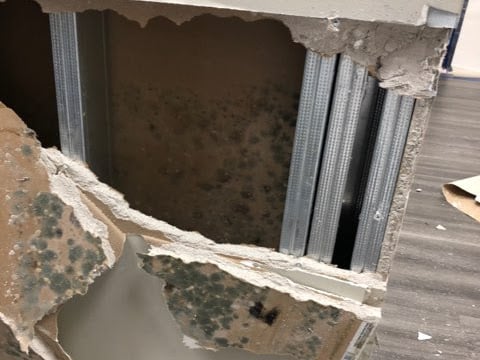Hidden mold on sheetrock inside a wall cavity can cause allergy-like symptoms in sensitive individuals if mold spores become airborne and are inhaled. Mold spores can also trigger an asthma attack in asthmatics. Airborne mold sampling for laboratory analysis in the presence of hidden mold growth can often reveal the existence of hidden mold growth problems. Call Angstrom Testing Services at 516-724-4574 to have your air quality checked for hidden mold growth problems.
Mold (mildew), mushrooms, and yeast are all types of fungi. Fungi are found both indoors and outdoors. Hundreds of different kinds of mold are commonly found in the United States and New York City.
Exposure to mold can cause or worsen asthma symptoms and allergies, such as hay fever. People who are allergic or sensitive to mold may experience congestion, runny nose, coughing and trouble breathing.
Some people are at risk for more severe reactions to mold, such as fever and shortness of breath. This includes people who are exposed to large amounts of mold at work such as, agricultural workers and building demolition workers. People who have had or are undergoing certain medical procedures, such as bone marrow or organ transplants and chemotherapy, are also at risk. Health symptoms usually disappear after the mold has been removed.
Identifying Mold
Mold can be different colors, including gray, black, green, yellow and orange. It may look furry, slimy or powdery. Some mold has a musty, stale or earthy smell.
Mold usually grows in wet or damp places. It can grow on paper, fabric, wallpaper glue, sheetrock, wood, soap scum, leather and other surfaces. It can grow where there is water, high humidity or damp conditions. Mold grows faster in warm temperatures and high humidity.
Exposure to Mold
You can breathe in mold particles if mold is disturbed or damaged. You can also breathe in tiny spores (similar to seeds) that mold may release into the air. Mold can get on your skin if you touch it. You can swallow mold if you eat moldy or spoiled food. If you think that you have symptoms related to mold exposure, you should see a health care provider.
Mold Prevention and Removal
The best way to prevent mold is to remove water and moisture sources. Fix leaks, dry damp areas and remove humidity from the air to help stop mold growth and keep it from coming back. Mold inspections and mold testing should be considered.
To remove mold:
- Seal off moldy areas using a plastic sheet and duct tape until cleaned. Keep children and pets away.
- Use water and soap to clean small areas of mold on walls or other hard surfaces when you see it. Wear waterproof gloves while cleaning.
- Dry the cleaned area completely.
- Clean any visible dust from work areas. Use wet mops or HEPA vacuums.
- Throw away all cleaning-related waste in heavy-duty plastic bags and seal securely.
If the mold returns quickly or spreads, there may be an underlying problem, such as a water leak. Report repeated mold problems to your landlord.
If large areas of mold are present, you may need outside help such as a professional mold abatement company. Be sure your contractor is licensed and follows NYS Labor Law requirements.
To report a large amount of mold in an apartment if you are a tenant, or if the mold is in a non-residential location, submit a complaint online or call 311.
Building Requirements
Landlords of buildings with three or more apartments, or buildings of any size where a tenant has asthma, are required to keep tenants’ homes free of mold. This includes safely repairing water leaks and correcting persistently high humidity levels.
For more information on controlling and removing mold hazards email NYCHNP@health.nyc.gov, or call 311 and ask for the “Healthy Neighborhoods Program.”

I like how you mentioned that gray, black, green, and yellow are just some of the many colors mold can be. My cousin is thinking of looking for an indoor air quality testing service because she’s considering selling her house and wants to ensure it’s as safe as possible for the new buyers. It seems like a good idea for my cousin to think about hiring a reputable professional to help test the breathing atmosphere in her home in case she does decide to sell it.
I always used to read piece of writing in news papers but now as I am a
user of web so from now I am using net for articles,
thanks to web.